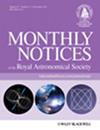Mean-motion resonances with interfering density waves
IF 4.8
3区 物理与天体物理
Q1 ASTRONOMY & ASTROPHYSICS
引用次数: 0
Abstract
In this work, we study the dynamics of two less massive objects moving around a central massive object, which are all embedded within a thin accretion disc. In addition to the gravitational interaction between these objects, the disc-object interaction is also crucial for describing the long-term dynamics of the multi-body system, especially in the regime of mean-motion resonances. We point out that near the resonance the density waves generated by the two moving objects generally coherently interfere with each other, giving rise to extra angular momentum fluxes. The resulting backreaction on the objects is derived within the thin-disc scenario, which explicitly depends on the resonant angle and sensitively depends on the smoothing scheme used in the two-dimensional theory. We have performed hydrodynamical simulations with planets embedded within a thin accretion disc and have found qualitatively agreement on the signatures of interfering density waves by measuring the torques on the embedded objects, for the cases of 2 : 1 and 3 : 2 resonance. By including in interference torque and the migration torques in the evolution of a pair of planets, we show that the chance of resonance trapping depends on the sign of the interference torque. For negative interference torques the pairs are more likely located at off-resonance regimes. The negative interference torques may also explain the $1~{{\%}}-2~{{\%}}$ offset (for the period ratios) from the exact resonance values as observed in Kepler multi-planet systems.具有干涉密度波的均动共振
在这项工作中,我们研究了围绕中心大质量天体运动的两个小质量天体的动力学,这两个天体都嵌在一个薄吸积盘中。除了这些天体之间的引力相互作用之外,圆盘与天体之间的相互作用对于描述多体系统的长期动力学也至关重要,尤其是在均动共振系统中。我们指出,在共振附近,两个运动天体产生的密度波通常会相干地相互干扰,从而产生额外的角动量通量。由此产生的对物体的反作用是在薄盘情景下推导出来的,它明确地取决于共振角,并敏感地取决于二维理论中使用的平滑方案。我们对嵌入薄吸积盘的行星进行了流体力学模拟,并通过测量嵌入物体上的力矩,发现在 2 : 1 和 3 : 2 共振情况下,干涉密度波的特征在性质上是一致的。通过在一对行星的演化过程中加入干涉力矩和迁移力矩,我们发现共振捕获的几率取决于干涉力矩的符号。如果干涉力矩为负,那么这对行星更有可能位于非共振状态。负干涉力矩也可以解释开普勒多行星系统中出现的1~{{\%}}-2~{{\%}}$(周期比)偏离精确共振值的现象。
本文章由计算机程序翻译,如有差异,请以英文原文为准。
求助全文
约1分钟内获得全文
求助全文
来源期刊

Monthly Notices of the Royal Astronomical Society
ASTRONOMY & ASTROPHYSICS-
CiteScore
9.10
自引率
37.50%
发文量
3198
审稿时长
3 months
期刊介绍:
Monthly Notices of the Royal Astronomical Society is one of the world''s leading primary research journals in astronomy and astrophysics, as well as one of the longest established. It publishes the results of original research in positional and dynamical astronomy, astrophysics, radio astronomy, cosmology, space research and the design of astronomical instruments.
 求助内容:
求助内容: 应助结果提醒方式:
应助结果提醒方式:


